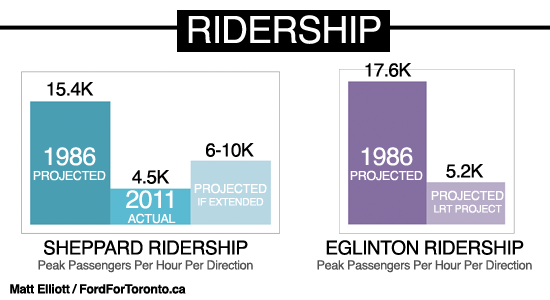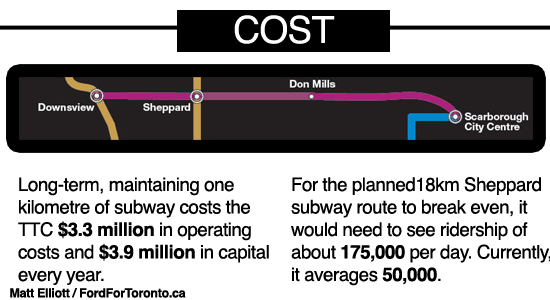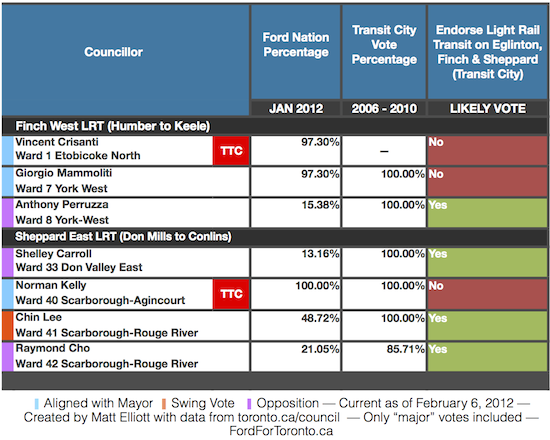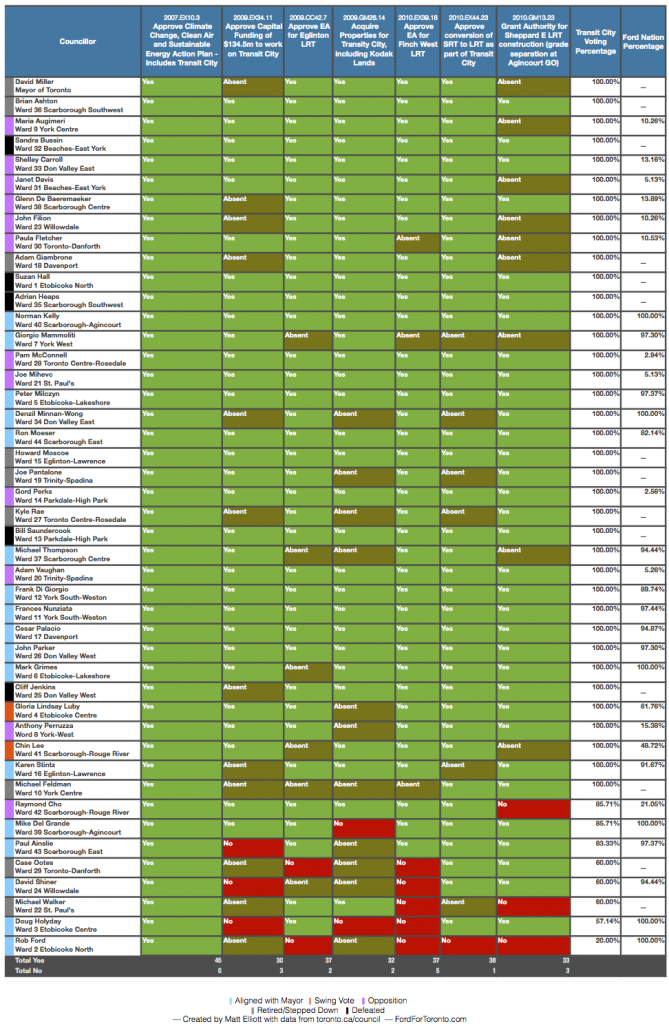The Globe & Mail’s Kelly Grant, on the issue that’s going to keep this week’s council meeting from being boring:
The embattled Toronto Transit Commission is about to undergo a major shakeup with chair Karen Stintz and her allies moving to dissolve the Ford-friendly board and replace it with councillors who support light-rail transit and private citizens.
Ms. Stintz will be putting her own job on the line Monday when she moves a motion to fire all nine current commissioners.
via Stintz readies motion to fire Ford-friendly transit commission | Globe & Mail.
This is shaping up to be yet another significant loss for Rob Ford. By a combination of law and custom, he’s supposed to be the one who sets the composition of boards and committees. Should council have the votes to do this – and every indication is that they do – the mayor of Toronto will have lost influence over the city’s biggest budget item. Major transit decisions will go forward without input from his office.
Some will attempt to spin this as the actions of a bitter and spiteful council that seeks to undermine the mandate of a democratically elected mayor. But that’s crap. What we’ll see this week is no less than Karen Stintz’s last resort after attempts at compromise were roundly rejected or undermined by the mayor and his friends.
There have been at least two major compromise attempts between Stintz and the mayor’s office since this whole transit battle took hold back in January. Both could have seen an outcome where Ford walked away looking like the winner. Instead, he rejected everything.
The First Compromise
The first major compromise is the more obvious one, since it played out in public. With this olive branch, Ford could have agreed to bring the eastern section of the Eglinton LRT above ground, build a two-stop extension of his beloved Sheppard Subway and deliver improved transit to Finch with a new busway project.
Ford probably could have played hardball with this deal, asking for further guarantee that the surface LRT wouldn’t impact traffic. During talks with the province after he took office, Ford was given an offer that would have seen Eglinton widened to ensure traffic flow wasn’t impeded.
This would have been an easy thing to spin as a victory. Ford gets his subway, along with a trumped up guarantee that the surface LRT wouldn’t impact traffic. And Finch gets some fancy buses. Everybody wins. Mostly.
The mayor could then spend the next several months talking up Gordon Chong’s report as the magic key that will allow for further construction on Sheppard.
But that’s not what happened, despite Stintz getting an initial assurance from Doug Ford that the mayor was open to the deal. Instead, the mayor flatly rejected the offer, sat through an awkward council meeting where he was overruled – he called it irrelevant – and then proceeded to call his hand-picked TTC chair a back-stabber.
The Second Compromise
This one is murkier, with most of it happening outside of the media.
Shortly after the TTC board fired Gary Webster, the impression I was given by several people is that council would quickly move to remove Ford-allied councillors from the TTC and replace them with people more amenable to council’s approved direction on transit. Also: there was a desire to ensure that the TTC board wouldn’t continue to fire long-time employees for spiteful and/or vindictive reasons.
But things soon changed. As of the middle of last week, stories started to emerge that Stintz and Ford had reached a compromise on the composition of the board. Having already agreed to allow for citizen representation, the two agreed that they would support a board of six councillors and five citizens, with the chair being chosen from the councillors. More importantly, the deal seemed to imply that the current TTC board would stay in place until June.
That was the deal on Wednesday. And still on Thursday. But on Friday, things changed: Stintz announced that she would be making a motion at this week’s council meeting that would call for an immediate change to the make-up of the board, removing all existing members and seeking replacements. Seven councillors will join the board immediately, with four citizens to join later on this summer following an appointment process.
What happened between Wednesday and Friday is anyone’s guess, but a late night Twitter posting by Stintz sheds some light on the situation: “My attempts at compromise with the Mayor were again undermined by Doug Ford & Nick Kouvalis,” she wrote. “The situation became untenable.”
The details of the announcement also point to this being a snap decision following some sort of renewed strife between the mayor and Stintz. Initially, Councillor Josh Matlow told the Globe that there would be a predetermined slate of councillors chosen to replace Ford’s allies on the TTC board. But Stintz quickly backed away from that story, and said it would be an open nomination process. (In the confusion, Matlow was unfairly criticized for what looked like a premature leak – it seems clear now that things were just happening really fast.)
The obvious speculation is that Stintz was hoping to find common ground with the mayor that would have seen him cease his efforts to invalidate council’s February decision on LRT. A compromise may have even included broad support for a Sheppard Subway extension, contingent on the mayor actually presenting a viable plan to pay for it.
Coincidentally, late on Thursday, Doug Ford took part in an extended media scrum in which he rejected the idea of all taxes and tolls as a way to pay for new transit. He called them evil. He also accused Ontario Minister of Transportation Bob Chiarelli of being biased toward LRT and made further claims that the Eglinton LRT plan was similar to the right-of-way project on St. Clair Ave.
What no compromise means
There’s lots to worry about going into this week’s meeting. Torontoist’s Hamutal Dotan cautions against a worst-case scenario in which half of council puts their name forward for a seat on the new TTC board, leading to a procedural circus and dozens of votes. I’m hopeful that there’s more organization in the works and that there is a chosen bloc of councillors with broad support ready to step in as commissioners.
But even if not, this is the only play Stintz has left. With every compromise rejected, a recomposition of the TTC board is imperative. Without it, the city goes forward with a situation where the guys controlling the majority votes on the TTC are actively against the council-approved plans for transit expansion. Given the sheer number of items related to these plans that are set to become before the commission, it’d be way too easy for the mayor to use his influence to alter or delay progress, creating procedural snags that would continually require council’s intervention.
That’s no way to build a railroad.











